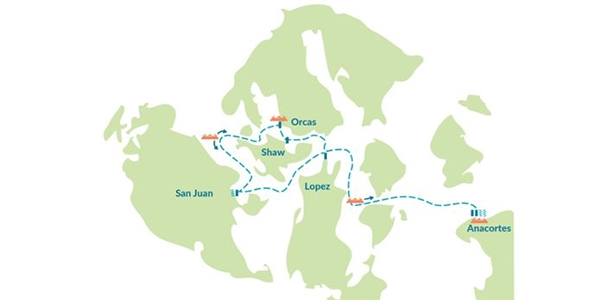— by Matthew Gilbert, Orcas Issues reporter —
As part of National Travel & Tourism Week, the San Juan Islands Visitors Bureau teamed up with the Chamber of Commerce to host the Bureau’s 20th Annual Spring Membership Luncheon. Held at the Outlook Inn on Orcas, a wide range of island-wide small business owners attended to hear how the coming season was shaping up and what to watch for in the future.
Councilman Rick Hughes led off with a summary of our beloved ferry system – Hughes sits on the Ferry Advisory Committee. It was a good news / bad news kind of report: The good news is that the state ferry system is committed to building five new ferries and converting its fleet to hydroelectric – the only one in the country, if not the world. The bad news is that none of that will help the San Juans in the foreseeable future even as ticket prices continue to climb to finance that expansion. Worse still, “we may be down a boat this season if we can’t keep the Hyak going after June 30,” Hughes reported. “Our capacity would drop 2500 cars, so plan ahead.”
On top of all that, Hughes said that to get a new boat, “San Juan County needs another ferry terminal.” The current mission for the Anacortes—San Juan fleet is thus to “keep the level of service where it is while getting caught up with maintenance so these boats can reach their 60-year lifespan.”
Visitors Bureau Executive Director Deborah Hopkins reported that tourism generated $251M in the county last year, and while that’s an impressive figure, the wear and tear is becoming more evident. In response, the Bureau is developing a series of videos under the title “Sustainable Tourism Matters” that focus on stewardship and the Leave No Trace program (www.LNT.org). “This is where destination travel is heading right now,” she said. The Bureau’s website, updated with new booking technology, received more than one million views last year.
Natl. Monument Manager Marcia DeChadenedes, representing the Terrestrial Managers Group, then gave an update on the county’s tourism study. Phase 1 reported extensively on the visitor experience and was published last June. Phase 2 research, with a guiding theme of “How can we better manage tourism in the future?”, focuses on the resident experience and will be implemented next month with a target of 1000 completed surveys. Local businesses are also a key part of this phase, and every member of the Bureau and the Chamber will receive a copy. It’s expected that the results will give shape to the ongoing tension between preserving a robust tourism economy and the growing threat of “loving the San Juans to death.” The combined results will then feed into a Tourism Master Plan, “the last main planning document for the County,” said Hughes.
Speaking to some of the issues that plan will have to address, Erika Shook, SJC Community Development director, reported that the average daily number of visitors in the county peaks at around 8500 people, just more than half the current permanent population of 16,000. In 20 years, the visitor-resident total is expected to exceed 30,000 on any given summer day, approximately a 25 percent increase based on projected yearly growth of one percent. That number may seem modest, but over time it has a multiplier effect in terms of inflow and impacts. That one percent figure is also debatable, rising and falling as the economy swings and potentially influenced by the forces of climate change. As one of the last few temperate climate shelters left, will the San Juans become a destination of last resort? Hughes believes that our limited ferry capacity provides a natural cap on growth. Perhaps.
The impact of short-term vacations rentals (VRs) remains top of mind for many and Shook reported that 1080 permits have been approved so far this year. Another 50 have received “notices of violation,” resulting in over $50,000 in penalties. “We’re trying to level the playing field with traditional accommodations,” she explained, referring to the County’s more aggressive regulatory approach which includes the completion of “certificates of compliance.”
The Planning Commission has asked Shook and the County to identify a “proper” number of VRs, while the Eastsound Planning and Review Committee (EPRC) recently submitted a resolution to the County that would place a 12-month moratorium on new vacation rental permits in the Eastsound Subarea. Hughes says he is still undecided on whether to support it, noting that “only 7 – 8 percent of all county residential units are VRs while 30 percent are unused second homes.”
That dismissal did not sit well with everyone, though. The simmering unrest around the competitive pressures of VRs was voiced by a local inn owner who observed that the real estate industry actively markets properties as having rental potential. “I run a small inn and we’re suffering,” she said. “The lodging industry feels unheard on this issue. How about creating a three-year wait period for new home buyers before they can rent their property?”
Although still months if not years away, the completion of the slow-moving Tourism Master Plan can’t come too quickly.
**If you are reading theOrcasonian for free, thank your fellow islanders. If you would like to support theOrcasonian CLICK HERE to set your modestly-priced, voluntary subscription. Otherwise, no worries; we’re happy to share with you.**







Another well written article on the elephant in the room. The tourism issue, including short term vacation rentals, (STVR’s) as it exists today can no longer be ignored. In it’s current mostly unregulated (i.e. unlimited) form this has the capacity to negatively affect the future of our island community in a way never before. This is, as one of the EPRC members intimated at the most recent meeting, “a crisis moment in the history of SJC.” Tourism, including STVR’s is an issue that can now only be looked at in terms of how it is affecting, (and will continue to affect) our communities BOTH positively and negatively. Thank you Mathew, Margi, and Orcas Issues for going here. This is an issue years past it’s prime and ripe for open discussion in realistic terms.
“As one of the last few temperate climate shelters left, will the San Juans become a destination of last resort?”
Good question– as climate change continues to challenge/diminish/threaten our quality of life it is now worth acknowledging that tourism hosts the 10th largest carbon footprint on the planet… as such, isn’t it time for us to consider whether continuing to push the limits on what has come to be a too big to fail institution is actually in SJC’s best long-term interests, or not? The completion of certificates of compliance, or the implementation of additional fees, are seemingly short-term, knee-jerk, anecdotal approaches that do not in any way slow down, inhibit, cap, or diminish the long-term negatives regarding what is currently an out-of-control economic engine that is vastly changing the nature of our communities. This is, as one member of the EPRC put it, “A watershed moment in the history of San Juan County.”
“Hughes believes that our limited ferry capacity provides a natural cap on growth. Perhaps.”
Perhaps indeed– This is short-sided. It reeks of the, “It’ll never happen here” syndrome. While the majority political will in the county continues to obscure the reality of what’s happening on the ground… they are at the same time continuing to push for more, (more ferries, more ferry terminals, more festivals, more infrastructure)– not in preparation for more “natural growth,” but for more visitors. The writing is on the wall.
Regarding the recently proposed moratorium on STVR’s while the issue is more closely studied– “Hughes says he is still undecided on whether to support it, noting that “only 7 – 8 percent of all county residential units are VRs while 30 percent are unused second homes.”
How many ways can this be interpreted? Perhaps when the 30% of the unused homes become vacation rentals will you then be citing that “only 37-38% of our county are VRs?”
The affordable housing issue is only a small part of the equation involving the well-documented negative impacts regarding tourism growth in seasonal resort communities. A prime example would be the gentrification now occurring in our community being driven by the current growth narrative. As the growth paradigm shifts from “slow to rampant” the norm has evolved into an “us,” and “them” mentality with such common phrasing as, “Where are we going to put the workers?”
For those who are not aware of the many down-sides to the STVR industry a good place to start is insideairbnb .
IMO, all of this supports the argument for “less,” not for “more.” I support the current proposal for a moratorium on STVR’s, and feel that any responsible resulting studies regarding this issue performed by the County should be viewed in it’s proper context regarding the larger issue of tourism itself.
I also challenge our current county leadership to quit side-stepping ALL of the known negatives surrounding these issues, (beyond just affordable housing). Educate yourselves, and quit obscuring the bigger picture. If you’re not willing to take part in discussions regarding long-term solutions at such a crisis moment in our county’s history then stand aside and let more progressive minds prevail.
I further feel it necessary that those counsel members who hold ownerships in STVR’s recuse themselves from the final vote.
‘Sustainable tourism” seems like one of those oxymoronic coinages that are used to obfuscate rather than serve as a realistic goal. Sustainability means restrictions to growth – socialism begins at home. ,
Rick Hughes hasn’t decided that we should pause and look at the impact of vacation rentals? This problem is impacting communities nationwide and worldwide. We need to take a hard look at how to regulate short term rentals which in reality are uncontrolled in San Juan County.
Off islands investors buying houses and converting to short term
rental, local investors buying houses and easily getting a vacation rental permit and selling with a bump in the price and doing it again, and again, owners with multiple vacation rentals.
This reduces available long term rentals and inflates home values
making affordability increasingly difficult. How could Rick pretend not to know this!?
We need someone on the county council that represents the Orcas community and not in some strange bubble.
Author Jared Diamond: “…as long as there is no effective regulation of how much resource each consumer can harvest…the correct rational response is to harvest before the next consumer can, even though the eventual result may be the destruction of the commons and thus harm for all consumers.”